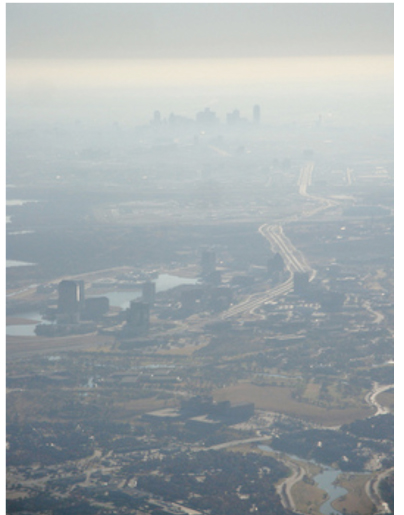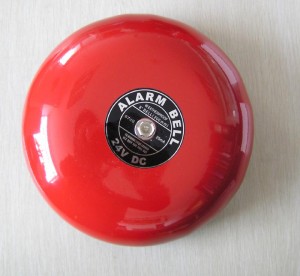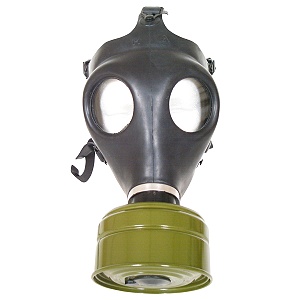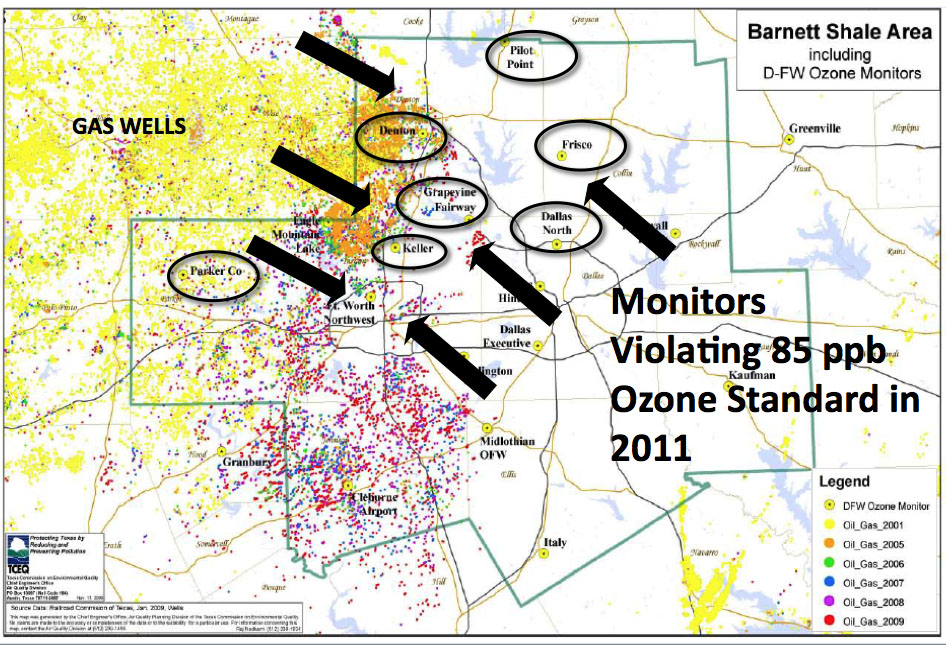Air Plan
Smog Update: On the Brink
 Strong winds are usually among the most efficient smog-stoppers DFW has. Despite this last week's record-setting heat wave, ozone levels didn't go crazy like they did in June because the winds kept blowing. Only the Rockwall monitor recorded an "exceedance" of the 1997 85 parts per billion ozone standard on Saturday, it's first of the season.
Strong winds are usually among the most efficient smog-stoppers DFW has. Despite this last week's record-setting heat wave, ozone levels didn't go crazy like they did in June because the winds kept blowing. Only the Rockwall monitor recorded an "exceedance" of the 1997 85 parts per billion ozone standard on Saturday, it's first of the season.
That makes 17 out of 20 DFW monitors that have at least one such exceedance of the 85 ppb standard. 11 of 20 have at least two. 7 out of 20 have at least three. And 2 out of 20 already have the four exceedances they need to be registered as a violation of the standard (a "non-attainment area" ozone monitor gets three strikes before the fourth-highest reading gets counted against it).
That means we're just one bad air day away from seeing five more monitors record their fourth exceedance and become violators. Two bad days away from having nine – and August is traditionally much worse for ozone than July.
In 2010, there were two monitors in violation of the 85 ppb standard. Last year there were seven. Industry and state government have been trying to tell the public DFW is still making air quality progress despite these numbers – that last year was just an anomaly because of the drought. Not sure how they'll spin another year of seven or more monitors out of whack with a 15-year old smog standard
Let's remind everyone again that according to Governor Perry's three TCEQ Commissioners, there were going to be no violations of the 85 ppb standard this year, that this is the second state plan in a row to fail to meet the 85 ppb standard, and that the new EPA smog standard is 75 ppb. Heck of a job TCEQ.
Rejected Smog Standard Would Have Saved 4100 Lives Annually – including DFW Residents
 The EPA-proposed ozone/smog standard of 70 parts per billion the White House rejected at the last minute in 2011 would have saved almost twice as many lives per year over and above the Bush-era standard of 75 ppb that was eventually adopted, according to a new study by John Hopkins University scientists.
The EPA-proposed ozone/smog standard of 70 parts per billion the White House rejected at the last minute in 2011 would have saved almost twice as many lives per year over and above the Bush-era standard of 75 ppb that was eventually adopted, according to a new study by John Hopkins University scientists.
Most of those new leases on life would have come in large cities like New York, Chicago, and Los Angeles, where smog levels are historically high. But researcher say the standard would also have saved a significant number of DFW lives as well.
The lower standard was rejected by the Office of Management and Budget, and Executive Branch agency that has grown to have veto power over almost all EPA regulatory decisions based on their economic impact – a variable specifically excluded from consideration in the Clean Air Act.
The John Hopkins team also concluded that the lower 60 ppb standard that was in the lower range of what was recommended by EPA's own science advisory would have saved up to 8000 lives per year, compared with the 2500 annual lives estimated to be saved under the more lenient 75 ppb standard.
In addition to more lives saved, the study concluded that millions of asthma attacks and acute respiratory problems would be prevented with a lower ozone standard.
“We contend that a more stringent standard would prevent a substantial number of adverse health outcomes,” wrote the researchers, led by senior scientist Frank Curriero of the Johns Hopkins Bloomberg School of Public Health.
They calculated the reduced deaths by incorporating data from a variety of health studies around the country that have found that whenever ozone levels rise, deaths and hospitalizations from cardiovascular and respiratory problems rise, too.
There was also a warning that climate change would make higher ozone levels more likely, as seems to be in play this year with much of the country experiencing the kind of drought and heat Texas had last summer, and with national ozone level spiking.
EPA officials estimated that achieving the rejected 70 ppb standard would cost between $19 billion and $25 billion per year, including the estimated $8 billion for meeting the current standard set by the Bush administration in 2008. However, the agency estimated the health benefits would be worth $11 billion to $37 billion per year. Based on new evidence of medical costs associated with ozone pollution, that figure may have been very conservative.
The EPA's next review of the standard is supposed to begin in 2013. The Clean Air Act requires an evaluation every five years; Jackson, however, had planned to act early until Obama asked her to stop.
Meanwhile, DFW still can't meet the old 1997 85 ppb standard after three clean air plans in the last seven years. This year's fate is already sealed thanks to the June smog attack we had early on. Our worst monitors are averaging above 85 ppb and we haven't gotten to August – traditionally our worst month. Smog is taking its toll on our health in DFW, even if it doesn't make the nightly news.
As Gas Mining Moves East, So Do Smog Violations
Failing the Test on Smog
 This is a response to statements in this.
This is a response to statements in this.
1) "The downward trend" that Mr Clawson of TCEQ says has only been "interrupted," is, in fact continuing, and he knows this because it's TCEQ monitoring that's proving it. This last March saw the highest ozone levels ever recorded for that month since TCEQ air quality monitoring began in 1997. It's only June, and there are already two monitors whose three-year runing average "Design Value" is above the old 85 ppb standard. The "best ever" ozone summer we were supposed to experience this year, according to TCEQ's prediction to EPA submitted in December, is completely off the rails.
2) The "87 ppb" Design Value Mr. Clawson cites is from 2010. Last year it was 92 ppb – at the Keller monitor. This year so far, the Keller monitor is already at a Design Value of 87, a violation of the old standard and something TCEQ said would not happen.
3) The NCTCOG claim that,"the DFW region has a tougher time than other metropolitan areas in the U.S. because of its climate plus its position downwind from outside sources of pollution" is also misleading. Houston is a hotspot for bad air, and yet last year DFW exceeded the number of bad air days and the severity of the violations in that city. Other metropolitan ares downwind of power plants as well as DFW, and yet they've all managed to do better in achieving cleaner air. Atlanta, Phoenix, and other Sunbelt cities that started out at the same smoggy spot a decade ago have all conquered the old 85 ppb std. DFW has not. It's already blown it again this year. Instead of blaming climate or coal plants, it is more realistic to blame DFW's air quality failure on a lack of political will by local and state officials to get serious about decreasing air pollution.
However, there is one large area of policy where the excuses of lack of will and new downwind sources collide – in the official lack of attention paid to the rise of Barnett and Haynesville Shale gas pollution as a source of smog in DFW.
4) The statement that only "5 percent" of the smog-forming emissions in DFW come from oil and gas drilling and production is also highly misleading. First, we know this is one of the fastest-growing categories of air pollution over the last decade. The increase in gas pollution is erasing decreases in emissions from other sources. Second, according to the information submitted by TCEQ to EPA last December, oil and gas emissions are the second largest source (20%) of smog-forming Volatile Organic Compounds, or VOCs in the 9-county DFW non-attainment area. That's more than the total VOCs produced by all on-road vehicles in the same 9 county area. Based on recent field studies by NOAA and others, this is probably an underestimate.
This statement also ignores the impact of gas emissions to the south and east of DFW, like Freestone County's, that are not included in the 9-county area inventory, but are probably influencing air pollution here.
What's always left out of this pie chart is the fact that cars now have a removal efficiency of approximately 90%. No other major sources come close to that kind of effort, despite technology being available to achieve it – at cement kilns, gas operations. and coal plants. That's where "the lowest hanging fruit" remains. But since all those industries are large contributors to the politicians directing the status quo, there's no political will to target them. Exhibit A: the 2011 DFW clean air plan submitted by the state, which relies primarily on marketplace forces to replace old cars with new ones, instead of any new round of pollution controls for any industry sources.
5) The NCTCOG claim that "monitors in the north Dallas and Frisco areas have had the highest readings of the region but the plume seems to be shifting west" is also based on old data. In fact, the opposite is occurring. Violating monitors are moving EAST (just like gas mining). And there are more of them. From 2008 to 2010, Eagle Mountain Lake and Keller were the epicenter of smog in DFW. But in 2011, while Keller tripped the std, EML did not. Moreover, during that same 08-10 period there were only 1-3 monitors in violation of that std. Last year, there were seven. And they included not just Keller and Parker County, but Denton, Grapevine, Pilot Point, Frisco and North Dallas – directly in contradiction to the NCTCOG claim.
This year, the very first monitor to record four "exceedances" of the 85ppb std was located near Mockingbird and I-35 in Central Dallas – the first time that monitor has done so since 2005. Moreover, the fourth exceedance came in June – the earliest that has happened since 2006, when 12 out of 19 monitors were in violation at the end of the summer.
As much as the officials and agencies would like us all to ignore the summer of 2011 and think of it as an aberation, it would be more prudent to see it as another warning sign that DFW needs to do much more to get safe and legal air.
June Smog Attack: Day 3
 High ozone levels continued to take their toll on people and monitors Wednesday. Grapevine joined the Hinton Street Dallas monitor in recording its fourth "exccedence" of the old 1997 85 ppb smog standard and so establishing an official violaiton of it.
High ozone levels continued to take their toll on people and monitors Wednesday. Grapevine joined the Hinton Street Dallas monitor in recording its fourth "exccedence" of the old 1997 85 ppb smog standard and so establishing an official violaiton of it.
This is an 8-hour standard wherein the average over eight hourly readings must be 85 or above, So we're not talking about short-term spikes. These are day-long spikes.
Monitors in Keller, Eagle Mountain Lake, Arlington, North Dallas and the Redbird area of southwest Dallas saw their third exccedence of the 85 ppb standard, meaning one more day of bad smog could also make them environmental crime scenes. Midlothian, Northwest Ft. Worth, and Frisco all have two exceedences as of yesterday,
We're going to wait until there's a pause in the bad news to look at how off the mark the all powerful and holy TCEQ computer model is so far, but suffice to say that after this week, there's not likely to be any monitor inside the nine-county area that will even be close.
Happy Ozone Non-Attainment Day!
 Ozone Non-Attainment Day is a traditional annual DFW event. Every summer there's a day when one or more air quality monitors records its fourth "exceedence" of whatever national ozone standard the region is violating. Then and only then does the monitor officially violate the Clean Air Act and put DFW in "Non-Attainment" of clean air once again.
Ozone Non-Attainment Day is a traditional annual DFW event. Every summer there's a day when one or more air quality monitors records its fourth "exceedence" of whatever national ozone standard the region is violating. Then and only then does the monitor officially violate the Clean Air Act and put DFW in "Non-Attainment" of clean air once again.
Gifts of inhalers, oxygen tanks, and emergency room visits are often exchanged by family members and friends on and around the actual day of Non-Attainment.
This year Governor Perry and the Texas Commission on Environmental Quality made sure our Ozone Non-Attainment Day arrived extra early. Usually, we don't see it come until August. In fact, ever since ozone monitoring began in 1997, there's only been one other year when it came as early as this year.
In 2006, we had Non-Attainment day on June 14th. Boy, that was a doozy of a summer – 12 out of 19 monitors eventually tripping. Think this one might be as big? It's sure possible.
One sign is that the monitor that triggered this year's Non-Attainment Day is the historic Hinton Street site near Mockingbird and I-35. This particular monitor hasn't even recorded a violation of the Clean Air Act since 2005 – so welcome back Hinton Street! But this site has a long and storied Non-Attainment history. The Hinton Street monitor recorded violations for five years straight during some of the worst smog pollution DFW has ever seen, from 2000 to 2005, with some of those years seeing 14 out of 18 monitoring sites recording violations.
So Hinton Street monitor violations are associated with really bad air. So are Non-Attainment Days that arrive in June. We could have one long hellacious summer ozone pollution episode ahead of us this year. Maybe even a return to double-digit monitors in violation. Isn't it exciting?
You may want to send Non-Attainment Day greetings to Governor Perry and TCEQ Chair Bryan Shaw, since it was their idea of watching people buy newer cars as a pollution control strategy, along with ignoring the large increase in smog-forming pollution from the natural gas industry, that made this June Non-Attainment Day possible. (Downwinders reminds you to please breathe responsibly).
New Evidence of Ozone Health Harms in the Air You’re Breathing This Week
 As of 10 am on Tuesday, air quality monitors in Grapevine, Midlothian, Frisco and the Redbird area of Dallas had already recorded "Level Orange" concentrations of smog, including a 106 ppb reading in Grapevine. As late as 9 pm last night, ozone levels were still in the 90's in Weatherford. It's going to be another long, hot day of bad air throughout the DFW area. Which means they'll be people suffering form breathing that bad air. Today there's new evidence that that suffering includes heart attacks and strokes caused directly by ozone pollution.
As of 10 am on Tuesday, air quality monitors in Grapevine, Midlothian, Frisco and the Redbird area of Dallas had already recorded "Level Orange" concentrations of smog, including a 106 ppb reading in Grapevine. As late as 9 pm last night, ozone levels were still in the 90's in Weatherford. It's going to be another long, hot day of bad air throughout the DFW area. Which means they'll be people suffering form breathing that bad air. Today there's new evidence that that suffering includes heart attacks and strokes caused directly by ozone pollution.
EPA Toxicologists at Research Triangle, North Carolina exposed willing subjects to clean air, or to air containing 0.3 parts per million ozone. On the high-ozone day, volunteers inhaled the same cumulative dose that they would have received over eight hours in a place that exceeded the U.S. federal limit of 75 parts per billion for that length of time. Just like we've been doing here in DFW for the past three days. The results of the study showed ozone is causing acute — and even chronic — risk for heart attacks in the people who breathe it.
Blood levels of inflammatory agents increased, sometimes even doubling, after the subject's ozone exposure, and this increase could last more than a day. High ozone exposure also triggered subtle changes in heart rate variability, indicating a higher risk of arrhythmias. Ozone also altered levels of several proteins involved in blood clotting.
A decade ago the head of the Texas environmental agency stated that Ozone was a "benign pollutant" and argued against lowering the national standard for exposure to it. Last year, Texas state government again fought a lowering of the ozone standard, saying there was no proof of harms at levels below 85 parts per billion despite an independent panel of scientists saying there was. The more we know about how ozone impacts the human body the more we see that even levels considered "safe" a few years ago have far-reaching harmful effects.
75, 85, 105 parts per billion. These are just numbers from monitors. Behind them are real people having asthma attacks, heart attacks, and strokes. This is why it's important to win the battle with DFW's chronic smog. This is why it's a public health issue that's too important to be left up to a group of political appointees in Austin beholden to industry that too often pretends there's not even a problem.
“Air Pollution Warning: Level Red”
 Monday turned out to be the single worst day for smog in DFW in 2012. Monitors in Northwest Ft. Worth, Grapevine, North Dallas and Dallas/Hinton Street recorded 8-hour averages of "Level Red" ozone – a level of pollution according to the Texas Commission on Environmental Quality that means,
Monday turned out to be the single worst day for smog in DFW in 2012. Monitors in Northwest Ft. Worth, Grapevine, North Dallas and Dallas/Hinton Street recorded 8-hour averages of "Level Red" ozone – a level of pollution according to the Texas Commission on Environmental Quality that means,
"The highest measured levels of ozone during the previous hour are considered unhealthy. Everyone, especially children, should limit prolonged outdoor exertion. People with respiratory disease, such as asthma, should avoid prolonged outdoor exertion."
Ten monitors exceeded the old 1997 eight-hour 85 ppb standard and those same three – Ft. Worth Northwest, Hinton and Arlington Airport, averaged over 100 ppb for eight hours or more.
In fact, Arlington saw a one-hour high of 128 ppb – an "exceedence" of a standard more than 20 years old – and it's 107 8-hour average on Monday was the highest at any DFW monitor since 2007.
The Hinton Street monitor recorded it's third exceedence since March. One more and DFW will once again be in non-attainment with the Clean Air Act, for the 21st year in a row. Four others recorded their second exceedence.
Last year it took us into the middle of Summer before that happened. This year it may occur during the first week of Summer. This is what Governor Perry and TCEQ call progress.
Halfway to Failure
 (Late Monday evening update: It's clear that the Hinton Street monitor will record its third "exceedence" of the 85 ppb standard this year, putting it just one away from making the entire region non-attainment" in 2012.)
(Late Monday evening update: It's clear that the Hinton Street monitor will record its third "exceedence" of the 85 ppb standard this year, putting it just one away from making the entire region non-attainment" in 2012.)
It's a bad sign when there are ozone problems on the weekends. It means that even with less people on the road and many businesses on less than full throttle, there's still enough pollution to cause trouble. And it usually means a rough week ahead. That's what happened on Sunday, when summer finally caught up with DFW in a big way.
Four area ozone monitors set new annual highs set on Sunday, and many others saw very alarming numbers during the afternoon. There were three "exceedences" of the old 1997 85 parts per billion ozone standard, and one of those was the second time the Dallas Hinton Street site had seen an 8-hour average above 85 this year. Six other monitors have already had their first. And it's only June.
Four such exceedences within a year puts a monitor in official violation of the obsolete standard that DFW is still struggling to meet. So with the Hinton Street results, we're already halfway to being out of compliance with the 1997 standard again. But it's all academic. Everything is now geared toward meeting the new 75 parts per billion ozone standard by 2018. DFW could be in violation of the old standard every year from now until then, and except for the terrible toll on public health, there'd be no penalty from either the EPA or TCEQ.
On the other hand, its going to be pretty hard to meet that new, harder standard when you haven't been meeting the old, easier one.
The state's official response is mostly to sit back and hope that DFW drivers trade in their older, more polluting cars for cleaner, newer ones. That phenomena was supposed to be responsible for making this year the best one for clean air in decades. According to the Texas Commission on Environmental Quality's computer modeling, no DFW monitor will violate the Clean Air Act for ozone pollution in 2012. At least, that's what they told the EPA when they submitted the region's clean air plan to the feds in December. And the EPA bought it. Because the TCEQ computer modeling said everything was hunky-dory.
But reality has a way of rudely intruding on TCEQ's computer modeling. Only six months into the new plan and most of the DFW monitor averages predicted by the state are already underestimates. We had the highest ozone levels ever recorded in March. Maybe there's just not enough of you trading in your cars.
 Or maybe it's just that old TCEQ junk science at work. One thing we know the state's computer model didn't consider was how already-dirty air makes the VOC pollution from natural gas operations more easily convert into ozone pollution. Denver officials who are also dealing with new gas operations contributing to long-standing smog problems have considered this factor and think it explains larger than expected ozone readings there.
Or maybe it's just that old TCEQ junk science at work. One thing we know the state's computer model didn't consider was how already-dirty air makes the VOC pollution from natural gas operations more easily convert into ozone pollution. Denver officials who are also dealing with new gas operations contributing to long-standing smog problems have considered this factor and think it explains larger than expected ozone readings there.
TCEQ chose to ignore this variable. Supposedly because the gas patch was well west of DFW and "couldn't possibly" affect North Texas ozone levels. But as anyone who's driven I-30 or I-20 over the past ten years can tell you, the gas patch extends all the way from east of Denton to Grand Prairie to Midlothian, encompassing most of the 9 county non-attainment area. In the same December 2011 clean air plan the state predicted record-low ozone levels this year, it also estimated that gas industry sources were emitting 34 tons per day more smog-forming VOC pollution than all the cars and trucks in DFW combined.
It was a political decision not to look at how dirty air from Houston, the East Texas coal plants, the Midlothian cement kilns and everything else east of Weatherford makes gas industry emissions more likely to cause ozone in North Texas. TCEQ's clean air plans are always full of such decisions that drive the final results of its supposedly objective computer modeling. Hard to believe now, but there was a time in the not-so-distant-past that the same computer modeling made it clear that the Midlothian cement plans "couldn't possibly" be affecting DFW ozone levels.
A plan to meet the new 75 ppb standard must be submitted to EPA by 2015 to show three years of compliance by 2018. That's only two-years away. If new cars alone can't get us down below 85, it will be extremely difficult for the state to argue they can get us down to 75. More actual things that work to reduce pollution will be necessary. Including bringing better controls to the cement kilns and coal plants and other industries still putting out way too much pollution. It will be a fight. but so far, the evidence is that more is needed if DFW is ever going to have safe and legal air.
More Details on the New DFW Smog Boundaries and Timeline
First, if you haven't read our updated post below, please notice the correction to Tuesday's initial story. DFW's "Moderate" classification by EPA under the new 75 ppb ozone/smog standard is actually a more serious ranking than Houston's "Marginal" ranking. In fact, areas with Marginal status are expected to be able to achieve the standard without even having to submit a clean-up plan with special pollution control measures. That's right, for the first time in forever, Houston won't even have to submit a "SIP" – State implementation Plan – while DFW will have to write yet another one, the fourth one in 15 years. According to EPA's announcement, most metropolitan areas were classified as "Marginal," identifying North Texas right off the bat as one of the more seriously smoggy places in America (but still way behind parts of California with an "Extreme" label slapped on the LA basin, and "Severe" for three more separate areas.) Most of DFW's sunbelt peers have fared better than our metormess. Atlanta started out at the same place as DFW 15-20 years ago, but has cleaned up its act enough to rate a "Marginal" in this round. Phoenix is also "Marginal." But of course neither one of those has a major natural gas play in the middle of them. Second, the timeline for the next DFW's next smog plan is known. The clock begins ticking 60 days after the new designations are published in the Federal Register – sometime between July and September of this year. From that date, DFW leaders and the Texas Commission on Environmental Quality have exactly three years – until the summer of 2015 – to design and build a new clean air plan for DFW that will meet the 75 ppb standard. We have a three year running average of 90.6 ppb. Not to worry however. TCEQ has already told us that ozone levels will drop to historic new lows this summer thanks to so many new cars being bought. On the outside chance that doesn't happen, the Rick Perry- driven TCEQ will have to find some other nonsensical rationalization for avoiding new controls on the Governor's industrial contributors – cement plants, the gas industry, and power plants, like they did last year with the new car strategy. But don't look for Austin to even start working on this clean air plan until 2014. There's no rush because the agency doesn't believe the 75 ppb standard is even necessary. The Commission's leadership was vocal in its opposition against it. If local leaders were smart, they'd disconnect their own clean air efforts from the state's and begin doing their own planning immediately, but traditionally they don't move until TCEQ says "jump". Add to this the new element of regional elected officials who, like Governor Perry, not only don't want to impose any new controls on industry, but don't even concede the value of cleaner air, and you already have a formula that's in danger of repeating last year's Worst Clean Air Plan Ever. 2015 isn't that far away, but without a serious overhaul of the regional air quality planning process, hope of meeting the new smog standard seems further than ever. By the way, counting our correction of the original story we ran on Tuesday, we've now published three posts on the new smog boundaries and deadlines. That's three more than any other source that we can find this morning.

